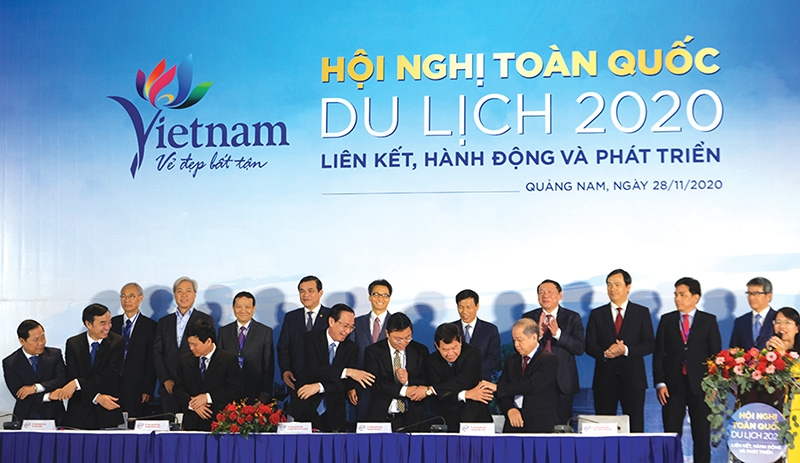Breathing brand new life into Vietnam’s tourism Industry
 |
| Breathing brand new life into Vietnam’s tourism Industry |
A survey by the Vietnam Tourism Advisory Board has shown that more than 20 per cent of respondents plan to travel during the Christmas and New Year holidays, and 12.4 per cent will consider trips on the occasion of Lunar New Year, while 18.2 per cent of respondents aim for a summer holiday. Among the most-favoured destinations are Dalat, Danang, Ha Giang, Nha Trang, Phu Quoc, Hanoi, and Ho Chi Minh City, each popular for its variety of activities, such as culinary and natural discoveries, cultural and historical exploration, and entertainment. Grasping demand, the tourism industry has launched many large-scale stimulus programmes, focusing on the innovation of products and linking different regions within specified itineraries, thus taking advantage of the strong points of each locality to retain tourists longer.
Powerful cooperation
Many famous tourist destinations have come together for the first time to cooperate for their development. As one of the top destinations, every year Ho Chi Minh City recorded an average tourism growth rate of 14 to 16 per cent. During the pandemic, the southern metropolis has still been one of the most popular tourist destinations in the country, despite the continuous drop in arrivals. The city’s success stems from the implementation of joint tourism development programmes with 43 out of 63 provinces in the country many years ago and the increasing scale of this cooperation, which further expanded its reach to the southeastern provinces in the Mekong Delta, the northwest, the northeast, and most recently Hanoi and the Central Key Economic Region.
Meanwhile, Hanoi has signed nine cooperation programmes with the departments of culture, sports, and tourism of 40 provinces and cities. In addition, the Hanoi Department of Tourism also coordinates with cable TV channel CNN to broadcast a promotion programme about its tourism, which integrates its own destinations with easy-to-reach places like Quy Nhon, Hoi An, Halong, and Ninh Binh.
Besides these regional programmes, some destinations designed packages on Christmas, New Year, and Lunar New Year, establishing combined programmes between hotels, tourist spots, and restaurants.
For instance, since the beginning of November, Danang has launched a dedicated demand stimulus programme for its citizens, including resort packages with 20-50 per cent discount at 4-5 star hotels and resorts, popular destinations, and special business event packages.
Elsewhere, Ha Giang province could already profit from its promotional activities on social networks and, at the end of November, welcomed more than 1.1 million guests with estimated revenue of over VND2 trillion ($87 million).
Nationwide, the Ministry of Culture, Sports, and Tourism reached encouraging achievements as the fruits of its labour. While in the first nine months of 2020, domestic tourists amounted to 37.5 million arrivals, with total revenue reaching VND233 trillion ($101 billion).
Embracing trends
Sparked by the initial success of combining localities’ efforts in tourism promotion, many firms have proposed additional solutions to help Vietnam’s tourism industry achieve even better results this year and beyond.
Duong Phu Nam, general manager of Sun World, the entertainment brand of Sun Group, said that the pandemic has created a shift in trends, and high-end resorts, healthcare, and eco-tourism are now the dominating trends.
Fortunately for Sun World, the group just launched Yoko Onsen Quang Hanh hot spring resort in Quang Ninh – just as domestic tourism revived. Considering trends and his group’s success, Nam suggested, “The government, tourism and related authorities should encourage businesses and improve conditions for them to launch new products that target trends in healthcare, beauty, and detox tourism.”
From the perspective of a foreign business, Amir Ohayon, vice president of Paradise Bay Resort commented, “Local tourism should offer a wider range of products customised for each segment so that consumers can emerge in the unique selling points of the country that can’t be found elsewhere.”
Many business representatives say that the traditional management approach is no longer capable of helping the industry adapt in the pandemic. Thus, accelerating digital transformation will create new opportunities for businesses to recover.
What the stars mean:
★ Poor ★ ★ Promising ★★★ Good ★★★★ Very good ★★★★★ Exceptional
 Tag:
Tag:
Related Contents
Latest News
More News
- The destinations powering Vietnam’s festive season travel demand (December 04, 2025 | 18:33)
- Vietnam named among the world’s most exciting winter destinations (December 04, 2025 | 15:10)
- Phu Tho emerges as northern Vietnam’s new tourism hub (December 01, 2025 | 17:00)
- Vietjet completes Airbus A320/A321 updates ahead of deadline (December 01, 2025 | 09:49)
- Vietjet resumes Con Dao flights from early December (November 28, 2025 | 15:24)
- Free tickets, Lunar New Year promotions on offer at Vietjet Mega Livestream (November 26, 2025 | 15:32)
- Scandinavian Airlines and Vietnam Airlines broaden agreement with new routes (November 25, 2025 | 17:04)
- Halong Cruise Port welcomes over 3,100 international visitors (November 12, 2025 | 18:06)
- Vietnam.travel climbs to second place in Southeast Asia website rankings (November 12, 2025 | 18:01)
- Cat Ba named among Southeast Asia’s top island adventures (November 11, 2025 | 18:09)





















 Mobile Version
Mobile Version